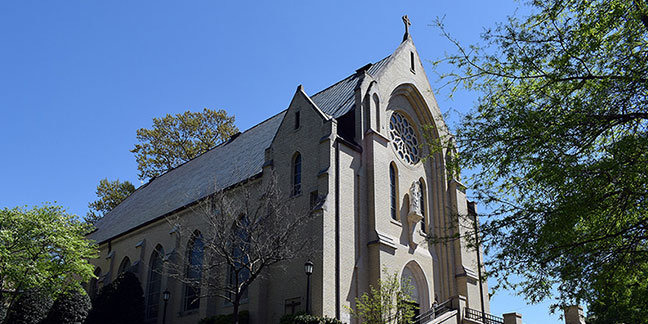 Built in 1939 as a parish church, St. Patrick Cathedral is no longer large enough to accommodate diocesan celebrations such as priest and deacon ordinations or the annual Chrism Mass – liturgies that draw hundreds of clergy and faithful. ( File | Catholic News Herald)CHARLOTTE — Upon his arrival in Charlotte, Bishop Michael Martin dove into details of the diocese’s planning for a new cathedral, focusing first on finding a location that would best serve the people of the Diocese of Charlotte so that design and cost considerations can be evaluated.
Built in 1939 as a parish church, St. Patrick Cathedral is no longer large enough to accommodate diocesan celebrations such as priest and deacon ordinations or the annual Chrism Mass – liturgies that draw hundreds of clergy and faithful. ( File | Catholic News Herald)CHARLOTTE — Upon his arrival in Charlotte, Bishop Michael Martin dove into details of the diocese’s planning for a new cathedral, focusing first on finding a location that would best serve the people of the Diocese of Charlotte so that design and cost considerations can be evaluated.
The diocese has identified several potential sites based on criteria recommended by a 19-member task force of Church and lay leaders, which last year concluded that a new cathedral is needed to replace the current St. Patrick Cathedral. St. Patrick was built as a parish church in 1939 and has long been too small to serve the growing diocese’s needs, the task force said.
“I’m deep in the weeds of the due diligence so I can fully evaluate where we are and where we need to go with the cathedral project,” said Bishop Martin, OFM Conv., who replaced retiring Bishop Peter Jugis in May. “While every diocese needs a mother church where people can come together with their bishop in communion with Jesus, I want to look at all of our needs as a faith community and allow for plenty of input from clergy and parishioners as we consider a project of such magnitude.”
The diocese announced in April that then-Bishop Peter Jugis had accepted the task force’s recommendation to build a new cathedral and that “all necessary preliminary work be done to allow construction to begin in 2030.”
Potential sites are mostly in and around Charlotte, the largest city in the diocese. Bishop Martin is looking at population projections and growth areas, and has asked several parishes with large churches and campuses to consider whether they would want to become home to the new cathedral. Another option would be to repurpose the site of the Diocesan Pastoral Center on South Church Street near uptown.
Emmett Sapp, diocesan director of construction and real estate, said, “We’ve done a lot of research, spoken to other dioceses, and consulted with architects – so we’ve got a solid foundation the bishop and the diocese can use as we consider next steps. If we decide to use the site of an existing church as the cathedral, there would almost certainly be some significant construction needed, so everyone involved will have to weigh that against building somewhere new.”
A new cathedral in Charlotte would follow a trend for the growing Catholic Church in the South.
Among the 193 Catholic cathedrals across the U.S., 15 have been built or expanded within the past 40 years – including six in the South to serve growing Catholic populations of Hispanic families and people moving in from the Northeast and Midwest. Costs for cathedral construction have ranged widely from $31 million in Knoxville in 2018, to $190 million in Los Angeles in 2002.
A cathedral serves as the mother church of a diocese, where the faithful can worship with their bishop, and is regarded with great reverence as the center for liturgical life. It is the bishop’s ceremonial seat of authority and the physical location of his “cathedra,” which means “seat” in Latin, from which he presides.
It is typically at the cathedral that a diocesan bishop officiates for significant liturgical occasions, ordains clergy, and consecrates the sacred chrism used in sacraments.
A new cathedral should be located in a vibrant area, the diocesan task force advised, to serve as a visible sign of the Catholic presence in the community. It must be easily accessible by private vehicles and public transportation so that everyone has the opportunity to visit.
— Liz Chandler
More online
Read more about planning for a new cathedral for the Diocese of Charlotte


